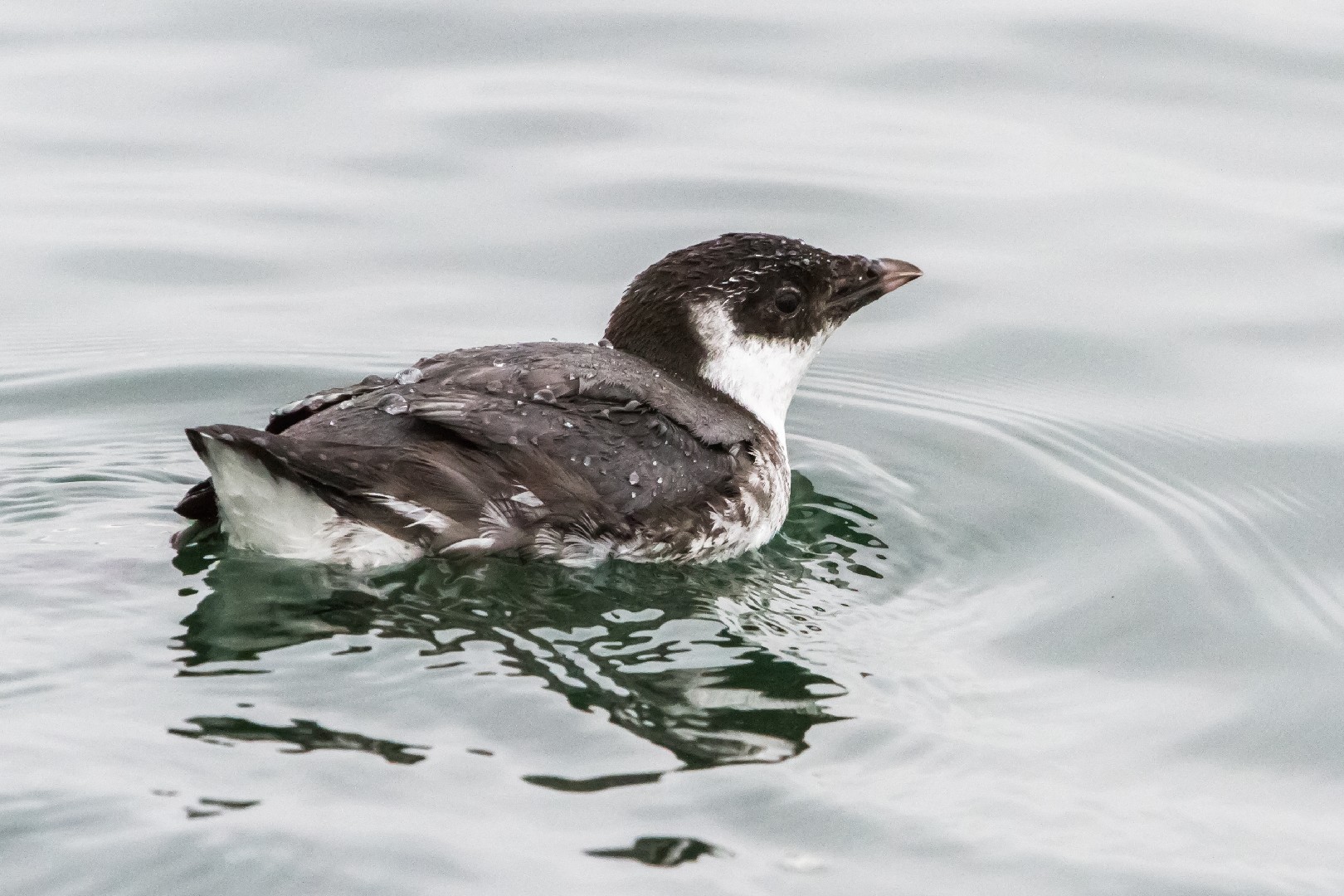Ancient Murrelet
A species of Ancient and Southern Murrelets Scientific name : Synthliboramphus antiquus Genus : Ancient and Southern Murrelets
Ancient Murrelet, A species of Ancient and Southern Murrelets
Botanical name: Synthliboramphus antiquus
Genus: Ancient and Southern Murrelets
Content
Description General Info
Description
This small auk species is black on the head, throat and rear neck, grey-backed, and has white underparts. The yellow bill is short and stubby. It has a small rounded black tail. The summer adults have white head streaks giving an aged look and leading to the English name. Other plumages are similar, but lack the crown streaks and black on the throat. Ancient murrelets tend to bank from side to side in flight to a greater extent than other small auks. They fly with fast wing beats due to their short wings. Measurements: Length: 7.9-9.4 in (20-24 cm) Weight: 5.4-8.8 oz (153-250 g) Wingspan: 17.7-18.1 in (45-46 cm) 
Size
25 cm (10 in)
Nest Placement
Burrow
Feeding Habits
Ancient Murrelet primarily consume small fish like shiner perch, capelin, and herring, as well as zooplankton, including krill species like Thysanoessa spinifera. They dive underwater, often in flocks, reaching the depths where prey resides. Diving behavior can attract predatory gulls eager to scavenge.
Habitat
Ancient Murrelet's primary habitat includes North Pacific islands with temperate coniferous coastal rainforests, grassy areas, and dense forbs. These regions offer access to nearby shelf or slope waters with temperatures ranging from 4-20°C. Ancient Murrelet nests within rocky or burrowed sites close to shorelines. Seasonally, some migrate to wintertime offshore continental shelf edges, influenced by upwellings and ocean currents for foraging.
Nest Behavior
Ancient Murrelet's breeding season begins by constructing or occupying a nest site, followed by laying eggs. The parents are jointly involved in incubating the eggs and caring for the young after hatch.
Nest Characteristics
Ancient Murrelet's nests are located in earthen burrows, natural cavities, rocky crevices, or grass tussocks. They can also adapt to wooden nest boxes. Entrances measure 3–5.5 inches wide, leading to burrows averaging 40 inches long, ending in a nest lined with grass, twigs, and leaves.
Dite type
Piscivorous
General Info
Feeding Habits
Bird food type
Behavior
Ancient Murrelet have distinctive nocturnal habits at their breeding grounds, arriving and departing under cover of darkness to avoid predators. They often engage in vocalization, with males emitting a rhythmic call near their nesting sites, which are small territories just a few feet in size. Aggressive interactions can occur between males over these territories. Both sexes participate in the digging and maintenance of their burrows. Intriguingly, younger ancient Murrelet, not yet of breeding age, visit the colony to learn the area and potentially prepare nest sites for future seasons.
Distribution Area
It breeds from the Yellow Sea (islands off China), through the Russian Pacific coast and the Aleutian Islands to the Haida Gwaii archipelago of British Columbia, where about half of the world population breeds. Some ancient murrelets migrate 8,000 kilometres (5,000 mi) from Canada to winter near Japan and China, even though the climate is similar at the two ends. It is the only bird known to cross the whole North Pacific. They then start a return trip in February, flying four or five hours a day. Genetic evidence shows that the species originated in Asia and only recently colonized North America, so their migration takes them back to their original homeland. In 2007, surveys off the Olympic Peninsula found unprecedented numbers of Ancient Murrelets with chicks, strongly implying local breeding. Other ancient murrelets however fly south in winter as far as California, and odd birds are found inland in North America, carried by autumn storms. The most remarkable record of this relatively short-distance Pacific migrant was a bird found on the island of Lundy, in Devon, England in the spring of 1990. Even more remarkably, what was presumably the same bird returned to this British island for the next two springs as well. 
Species Status
The ancient murrelet is listed as of 'Special Concern' by the committee on the Status of Endangered Wildlife in Canada because populations have been greatly reduced over the past century by mammalian predators such as rats introduced to their breeding islands by visiting ships in the 1800s. On one island, the number of breeding pairs was reduced from 200,000 pre-infestation to about 14,000 in the 21st century. In 2009, a five-year $2.5m Night Birds Returning project was instituted by Parks Canada, Haida Nation, Island Conservation and Coastal Conservation to restore Murrelet population by eradicating rats in the Gwaii Haanas National Park Reserve and Haida Heritage Site. For success, every single rat needs to be killed as a single pregnant rat can repopulate an island in 1–2 years. In 2011, ground-based eradication was implemented on Arichika and Bischoff islands. Phase 2 consisted of using aerial drops of poisoned pellets selectively attractive to rats. This was conducted in fall of 2013 on Murchison and Faraday islands. Continued monitoring is required for two years before an area can be declared rat-free. 
